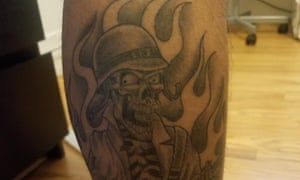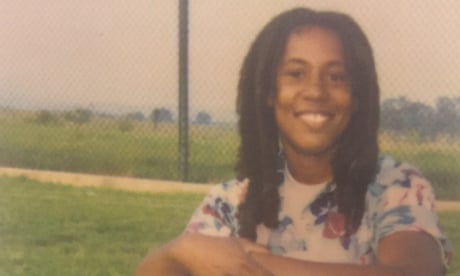Police violence, cliques, and secret tattoos: fears rise over LA sheriff 'gangs'
Investigation faces skepticism amid concerns that groups, linked to a history of attacks on inmates, are resurgent


To Sweeney, who had cut his teeth as an associate of the legendary civil rights lawyer Johnnie Cochran, the 2016 killing smacked of an execution, the work of renegade police officers reveling in violence for the sake of it. It was no more than a hunch, at first.The police claimed that Taylor had been wearing gang colors – Compton is the birthplace of the notorious Crips and Bloods – and had pulled a semi-automatic handgun from his waistband. But no gun was ever found at or near the scene, and Taylor was not suspected of being involved in criminal activity when the officers approached.“They stopped him for no reason. No reason!” Sweeney said in an interview with the Guardian. “He’d gone out to buy a Sprite and a single [cigarette]. And it hit me that something was going on, that they were doing this to become a member of something or to gain favor … because this is not policing.”Sweeney later learned that the same two officers had delivered a savage beating to another young black man in Compton a few months earlier. Sheldon Lockett had been standing with a friend outside his godmother’s house in broad daylight when, according to eyewitnesses, the officers showered him with racial abuse, repeatedly used a Taser on him and shoved a night stick into an eye socket, causing him permanent damage. Again, the officers claimed to have seen a gun. Again, no gun was ever found.Then came the moment of truth.At a deposition hearing in May, Sweeney asked one of the officers, Samuel Aldama, if he harbored racial animus toward African Americans, and Aldama spent close to five minutes struggling to give an answer. At first Aldama said he did have ill feelings, then changed tack and said he’d misunderstood the question.Next, Sweeney asked Aldama if he had a tattoo. After some hesitation, Aldama showed an elaborate image on his calf of a frightening skeletal figure wielding a rifle. Between 10 and 20 deputies at the Compton station had the same tattoo, he acknowledged.Sweeney hadn’t known about the tattoo in advance. But he did know that the Los Angeles sheriff’s department had a history of violent gang-like cliques that glorify violence for its own sake and pressure deputies to break the rules so they can prove their bona fides and “earn their ink” in the form of just such hidden tattoos.Read moreThe revelation wasn’t just a Perry Mason moment in court. It has jolted civic leaders in Los Angeles, just a few years after an epic scandal in which sheriff’s deputies, supported and protected by senior officers up to the sheriff himself, were found to have engaged in systematic beatings of prisoners, helped smuggle drugs and other contraband in and out of jail on behalf of White Power gang leaders, and worked to conceal aspects of the scandal from the FBI.Lee Baca, the former sheriff, as well as his former No 2 and close to a dozen former sheriff’s deputies, have been prosecuted and convicted of an array of offenses from abuse of police power to obstruction of justice.Jim McDonnell, the current boss of what is America’s largest county police department, has ordered an internal investigation into what he called “renegade cliques” and insisted – despite an official finding by the district attorney’s office last year in favor of Aldama and his partner, Mizrain Orrego – that the Compton incidents are still being investigated.That has done little to satisfy McDonnell’s internal critics, who complain he has been a reformer in name only, and threatens to cast a harsh spotlight on everything from controversial shootings to staff and equipment shortages as McDonnell faces an unexpectedly tough re-election battle against a 30-year department veteran in November.It has also incensed civil rights leaders, six years after a county report coauthored by McDonnell (then police chief in the port city of Long Beach) which described how deputies belonging to secret cliques would dare each other to beat or kill jail inmates and let them add details to their tattoos every time they did. Deputies would sometimes get into fights with rival clique members – including a notorious dust-up at a department Christmas party in 2010 that led to six deputy firings – or beat up honest deputies who refused to accept the dare.The concern is that this behavior is now making a resurgence, in part because some rank-and-file deputies have developed an us-versus-them mentality following the rise of Black Lives Matter and other civil rights groups angry about police shootings of civilians, and in part because the department brass has not been cleaned up the way McDonnell promised when he took office.“This goes a whole lot higher up in the Compton station,” Sweeney charged. “The captain claims he didn’t know. These officers change from their civilian clothes into their uniforms in the locker room every day, and you’re going to tell me, up to 20 people have that tattoo and it’s not going to raise questions? Of course they knew about it.”A union representative at a different sheriff’s station, who spoke frankly on condition that he not be identified, told the Guardian that not all tattoos were equal. Some deputies got them as a mark of genuine pride, an indication that they were willing to do the job right and go after violent criminals regardless of the risks. For others, though, tattoos were more secret, and more sinister.“Why does it have to be a skull holding a rifle? How does that stand for hard work?” the union rep said of the Compton ink. “What it indicates is more of a thug mentality, doing things that are – wink, wink – not exactly above board. It starts to change the way deputies treat each other. At the East LA station, friends have told me about three different tattoos. Sometimes the three groups fight each other. That’s totally unacceptable, not at all how cops should be behaving.”A decade ago, the department was in thrall to a shadow leadership structure in which deputies were encouraged to “work in the gray”. Many maintained a code of silence about abuses both to protect each other and to earn promotions. Dirty cops who kept to the code were said to be “in the car” with the undersheriff, Paul Tanaka, a one-time member of the notorious clique the Lynwood Vikings.In his youth, Tanaka had been one of five Viking officers held responsible for the killing of an unarmed Korean immigrant who ran a stop sign in Lynwood in 1988. Three years later, a federal judge described the Vikings as a “neo-Nazi, white supremacist gang” who routinely flouted the constitution. The department ended up paying nearly $10m in settlements because of the Vikings’ actions, and Tanaka’s career appeared doomed – until Baca took office and put him on the fast track to the top.As undersheriff, Tanaka had an executive email list of trusted underlings – a list that many in the department hoped McDonnell would use for guidance in purging the ranks. Instead, insiders say, McDonnell has kept many of Tanaka’s former acolytes and in several instances promoted them. (Tanaka himself is serving a five-year sentence for conspiracy and obstruction.)All that is likely to come under renewed scrutiny as the November election approaches. The dark horse candidate challenging McDonnell, the retired police lieutenant Alex Villanueva, has based his entire campaign on the need for reform and what he calls a corrupt political patronage system shredding morale.“In comes McDonnell and not only did he leave the entire system intact,” Villanueva told the Guardian, “he left the key players intact in the same positions and promoted them … He’s surrounded himself with people giving him bad advice. It’s the fox guarding the henhouse.”The union rep broadly concurred. “The rank and file absolutely loathe McDonnell,” he said. “I don’t know if it’s a compulsion or a delusion, but he’s focused almost entirely on the cosmetic. He has done almost nothing towards serious reform, and the radio frequency goes down about once a week, but we’re spending $1m to replace the silver buttons on our belts with brass ones. What has that got to do with anything?”McDonnell himself has sought to play down the significance of the Compton shootings, saying the revelations in Aldama’s deposition do not “in any way reflect [the sheriff’s department] of today”. The captain at the Compton station told the Los Angeles Times that Aldama was confined to desk duty, while Orrego has been fired for an unrelated offence.John Sweeney, however, is continuing to apply the pressure. In the next few days he will put billboards up around Compton asking for anyone who believes he or she has been victimized by Aldama or Orrego to come forward. “We suspect there are a lot of victims of this gang,” Sweeney said. “This may be the tip of the iceberg.”Since you’re here…… we have a small favour to ask. More people are reading the Guardian’s independent, investigative journalism than ever but advertising revenues across the media are falling fast. And unlike many news organisations, we haven’t put up a paywall – we want to keep our journalism as open as we can. So you can see why we need to ask for your help.The Guardian is editorially independent, meaning we set our own agenda. Our journalism is free from commercial bias and not influenced by billionaire owners, politicians or shareholders. No one edits our Editor. No one steers our opinion. This is important because it enables us to give a voice to the voiceless, challenge the powerful and hold them to account. It’s what makes us different to so many others in the media, at a time when factual, honest reporting is critical. The Guardian’s investigative journalism uncovers unethical behaviour and social injustice, and has brought vital stories to public attention; from Cambridge Analytica, to the Windrush scandal to the Paradise Papers.If everyone who reads our reporting, who likes it, helps to support it, our future would be much more secure. For as little as $1, you can support the Guardian – and it only takes a minute. Thank you.
